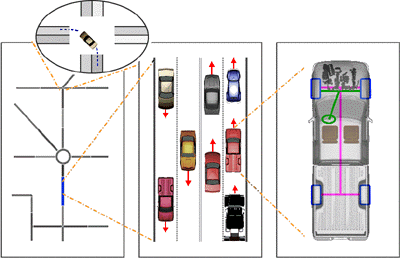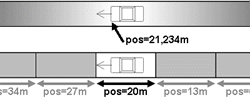Traffic Simulation Classes#
In traffic research, four classes of traffic flow models are distinguished according to the level of detail of the simulation. In macroscopic models traffic flow is the basic entity. Microscopic models simulate the movement of every single vehicle on the street, mostly assuming that the behavior of the vehicle depends on both, the vehicle's physical abilities to move and the driver's controlling behavior (see ChowdhurySantenSchadschneider2000). Within SUMO, the microscopic model developed by Stefan Krauß is used (see Krauss1998_1, Krauss1998_2), extended by some further assumptions. Mesoscopic simulations are located at the boundary between microscopic and macroscopic simulations. Herein, vehicle movement is mostly simulated using queue approaches and single vehicles are moved between such queues. Sub-microscopic models regard single vehicles like microscopic, but extend them by dividing them into further substructures, which describe the engine's rotation speed in relation to the vehicle's speed or the driver's preferred gear switching actions, for instance. This allows more detailed computations compared to simple microscopic simulations. However, sub-microscopic models require longer computation times. This restrains the size of the networks to be simulated.

Figure: The different simulation granularities; from left to right: macroscopic, microscopic, sub-microscopic (within the circle: mesoscopic)
Within a space-continuous simulation each vehicle has a certain position described by a floating-point number. In contrast, space-discrete simulations are cellular automata. They divide streets into cells and vehicles driving on the simulated streets "jump" from one cell to another.

Figure: The difference between a space-continuous (top) and a space-discrete (bottom) simulation
Almost every simulation package uses its own model for vehicle movement. Almost all models are so-called "car-following-models": the behavior of the driver is herein meant to be dependent on his distance to the vehicle in front of him and of this leading vehicle's speed.
User Assignment#
It seems obvious, that each driver is trying to use to shortest path through the network. But when all are trying to do this, some of the roads - mainly the arterial roads - would get congested reducing the benefit of using them. Solutions for this problem are known to traffic research as user assignment. For solving this, several approaches are available and SUMO uses the dynamic user assignment (DUA) approach developed by Christian Gawron (see Gawron1998_1).
